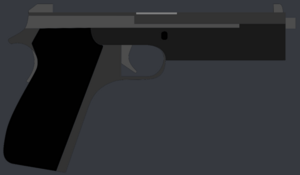TP-68 Pistol
| Tjenestepistol 1968 | |
|---|---|
 | |
| Type | Semi-automatic pistol |
| Place of origin | |
| Service history | |
| In service | 1968-Present |
| Used by | |
| Production history | |
| Designer | Mejner Saxe af Plønborg |
| Designed | 1956-1965 |
| Manufacturer | Bechsgaard & Olufsen Industri Syndikat .IKmbA |
| Produced | 1965-Present |
| Specifications | |
| Weight | 1.12 kg |
| Length | 216 mm |
| Barrel length | 122 mm |
| Cartridge | 9x19mm MagSec |
| Action | Gas-delayed blowback |
| Feed system | 13-round detachable box magazine |
| Sights | Ghost ring iron sights |
The TP-68 is a Semi-Automatic Handgun designed by hr Mejner Saxe af Plønborg and manufactured by Bechsgaard & Olufsen Industri Syndikat .IKmbA (BOIS IKmbA) in Rådyrborg, Lyngaard.
It is an all-steel frame pistol chambered in 9x19mm MagSec. Designed between 1956 and 1965, it entered into Lyngaardian service after competing in the Future Service Pistol Program (Fremtidige Tjenestepistolprogram) between 1965 and 1967. The pistol has served on foreign deployments global with the Lyngardian Royal Armed Forces. Specifically in Operation Håb og Ret, part of the wider Peace Kepping Inititives during the Third Asemese Civil War.
History
The Pistol was the creation of hr Mejner Saxe af Plønborg, a Banker who took part in hunting and sport shooting compitions. In 1956 he was competing in a target shooting match hosted by Hertug Jullius af Breddal where he would borrow a Akker LS Revolver. The Akker was unique because it obtained better accuracy by lowing the the bore axis (hight of barrel over hand) by firing from the lowermost chamber in the cylinder. Inspired by this he would attempt to bring this same concept to automatic handguns, taking inspiration from Langston Horn's Model 10 Pistol and his earlier Model 7 Pistol.
Plønborg would make several mock ups in his spare time, eventually partnering with Bechsgaard & Olufsen Industri Syndikat in 1962 after meeting with the companies CFO Markus Molzen at a dinner party. The company would establish a design team to build upon Plønborg's initial prototypes. In 1964 the Royal Army announced its intentions to hold the Future Service Pistol Probram in order to replace the aging Tjenesterevolver. BOIS would complete their first limited run of pistols using Plønborg's pattened Spring Chamber mechanism. Plønborg himself was offered the possition of Corporate Reprasentative by BOIS in 1965 and headed the team that would present the pistol to the program directors on the Royal Board of Military Affiars.
The Board was headed by Greve Cristoffer Mikel Andreas who was part of the same graduating class as Plønborg at the Sankt Ulfa School. The prototypical model, the EkKP-2 would be selected for the final rounds of testing, after a year on incramental updating during tsting the pistol was formally adopted as the Tjenestepistol TP-68, with the army filing an initial 2,500 unit order for that fiscal year.
Design
Plonborg original prototypes were originally built from Horn Model 10 and Horn Model 7 parts as well as custom milled parts. The Production pistols wer made of two main frame parts, all milled from steel billets. The pistol used a four spring recoil system. the Pistol used a gas-delayed blowback system, with one recoil spring around the barrel, where gas from vents in the barrel are used to retard the rearward motion of the slide. three other springs are used under the barrel to provide extra resistance but are not affected by the gas-delayed system. The barrel is integral to the lower frame, with a non-resiprocating top strap what atteches to the chamber. this allows for the top signs to remain stationary while being fired. The pistol is striker fired. The pistol has no manipulatible safety, rather it used only a grib saftey that prevents the sear from moving until the saftey has been adequately depressed.
The design has for years been praised and criticized. a survay done by the Ministry of Defense in 1989 showed that soldiers appreciated the low recoil and accuracy. However many noted that the pistol was overly heavy and the slide was dificult to pull back for many soldiers in stressful situations. it was the dificulty to manipulate the slide that was blamed for the death of Pol Ditmar, a peacekeeper who was macheted to death in Upper Asema, many eye witnesses noted that Ditmar ran away from his attacker, pulled his pistol, inserted a magazine and then striggled to fully rack the slide, ultimatly leading to his death. This accusation is strongly rebuked by BOIS and Plonborg himself, instead blaming Ditmar for following military doctrin and not carrying his firearm loaded (this pracitice was revised and is no longer practiced in part because of the Death of Pol Ditmar). In 1999, a survay by soldiers who used their TP-68 in Upper Asema also noted that the pistol was unable to stand up to ingres and filth. a subsaquent series of stress tests by 3rd party company Bjorn & Aarbjorg found similar issues, directly contradiicting the finding in the Future Pistol Program. While the army recognized these results it has not moved to fix them since.
Variants
- TP-68/OKT-MS: introduced in 2013 for use by the 3. luftbåren Battalion. It has a optic cut on the top strap for attaching a micro reddot optic. it also adds the attachment rail under the barrel from the MS.
- TP-68/MS: adds a attachment rail under the barrel.
- TP-68/SK: 10×25mm version
- TP-68/FA: Fully Automatic version made by Nationalt Støberi og Våbenhus, for use by special forces, saw limited adoption from 1998-2000 and its use was discontinued in 2000.
- EMP mk1 - SK: Experiamental TP-68/FA chambered in 10×25mm